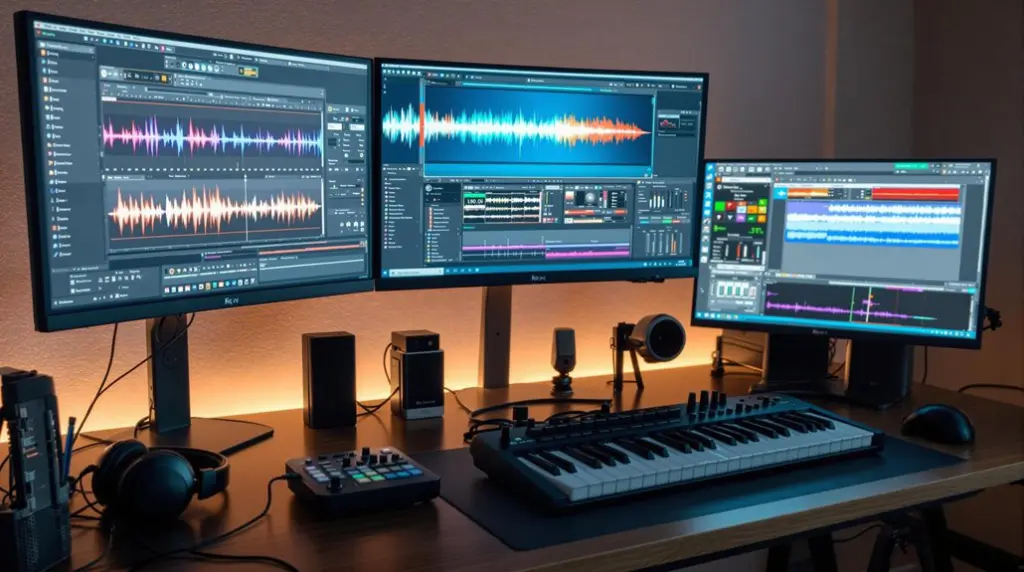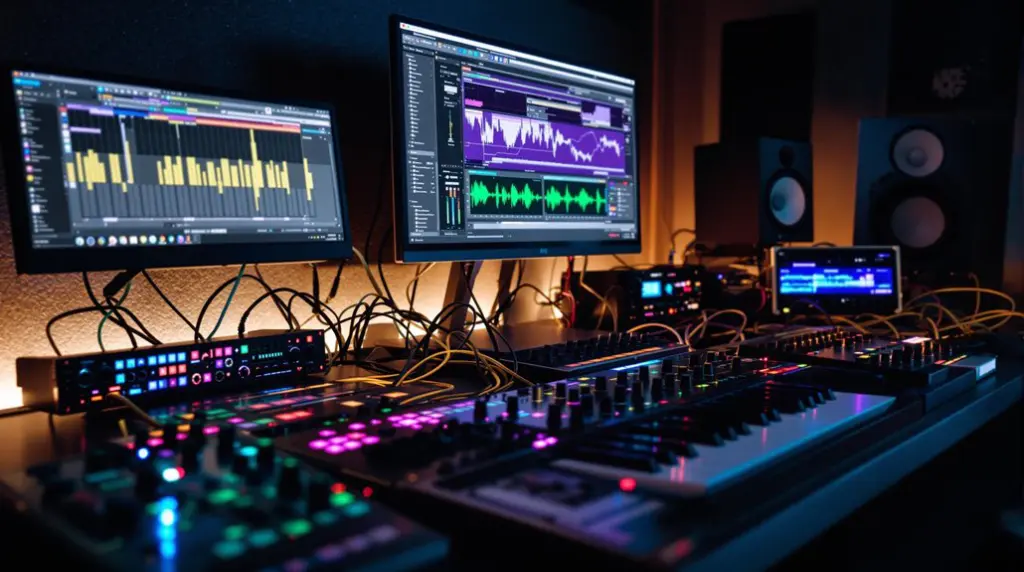First, locate your Mac’s 3.5 mm analog line out port, often marked with a headphone icon. Next, gather a 3.5 mm stereo connector that splits into two mono cables compatible with your studio monitor’s inputs (XLR, TRS, or RCA). Make sure the cables are high-quality and well-shielded. Finally, connect the cables to your monitors and power cycle them. Verify and adjust input settings on the monitor’s on-screen display if needed. If issues persist, examine all connections and swap out cables to rule out defects. Ready for an in-depth walkthrough to guarantee pristine audio quality?
Key Takeaways
- Identify your Mac’s analog line out port with a 3.5 mm stereo connector.
- Use a 3.5 mm stereo connector split into two mono cables or RCA cables.
- Verify the compatibility of your Mac’s output port with your studio monitors’ input types.
- Ensure cables are of good quality and appropriate length to minimize interference.
- Power cycle your monitor and check all cable connections to troubleshoot signal issues.
Identify Ports and Connections
Identifying the ports and connections on your Mac is crucial for guaranteeing a seamless interface with your studio monitors. Start by locating the analog line out port on your Mac. Typically, this is a 3.5 mm stereo connector, which you’ll use to split the audio signal into left and right channels. To identify this port, look for the small headphone icon; it’s usually situated on the side or back panel of your Mac.
Next, verify compatibility between your Mac’s output port and the input options on your studio monitors. Most studio monitors will have a variety of input options, including balanced XLR, TRS, or unbalanced RCA connectors. Refer to the user manual of your studio monitors to confirm the specific input types they support.
For a cost-effective solution, consider using RCA cables. These can easily connect from a 3.5 mm stereo jack on your Mac to the RCA inputs on your studio monitors. Always double-check the compatibility to avoid any signal loss or audio quality issues.
Properly identifying these ports and connections will set the stage for a successful and high-quality audio setup.
Gather Necessary Cables
After identifying the appropriate ports and connections on your Mac and studio monitors, gather the necessary cables to guarantee a seamless audio interface.
Start with a 3.5 mm stereo connector to link your Mac to the studio monitors. This connector will need to be split into two mono cables, ensuring you have a dedicated line for both the left and right speakers.
When choosing cables, consider using RCA cables, which are a critical option that still delivers reliable performance. Make sure these cables are compatible with the input/output ports of your Mac and studio monitors.
The cable quality is essential—opting for higher-quality cables can minimize signal degradation and ensure a cleaner audio transmission, even if you’re on a budget.
Length considerations are equally important. Measure the distance between your Mac and the studio monitors to select cables that are long enough to reach without being excessively long, as this can introduce signal interference.
Interference prevention is key; shorter, well-shielded cables are less prone to picking up unwanted noise. By meticulously selecting the right cables, you’ll set the stage for excellent sound quality and a professional audio setup.
Troubleshoot Signal Issues
To troubleshoot signal issues effectively, start by power cycling your monitor by simply turning it off and on again. This often resolves minor glitches.
Next, verify and adjust the input source settings in the monitor’s On-Screen Display (OSD) menu. Make sure your monitor is set to the correct input source that matches the cable connected to your Mac.
Check all cable connections between your Mac and the monitor. Loose or improperly connected cables can cause signal issues. Disconnect and reconnect each cable, making certain of a snug fit.
If problems persist, swap out the current cables with different types (e.g., HDMI, DisplayPort, Thunderbolt) to rule out cable-related issues.
Signal interference solutions may also involve eliminating nearby electronic devices that could cause disruptions. Make sure your monitor and Mac are placed away from potential sources of electromagnetic interference.
If troubleshooting display problems using these steps doesn’t resolve the issue, reaching out to customer service for further assistance is advisable. They can provide more advanced diagnostics and potential hardware fixes.
Frequently Asked Questions
How to Connect Studio Monitor to Mac?
To connect your studio monitors to your Mac, use balanced XLR or TRS cables. Utilize an audio interface for best control. Confirm correct input settings on your monitors and adjust volume levels for balanced audio output.
How to Connect to Studio Monitors?
To connect to studio monitors, use balanced TRS or XLR cable types for best quality. Invest in audio interfaces for enhanced sound control. Guarantee proper grounding and adjust volumes on both the monitors and your device.
How to Connect a Macbook to a Monitor?
First, confirm adapter compatibility between your MacBook and monitor ports. Use a Thunderbolt or USB-C cable, managing cables neatly. Adjust display settings for best resolution and color. Consider adapters for different port types.
How to Connect Multiple Monitors to Mac Studio?
To connect multiple monitors to your Mac Studio, use an audio interface. Guarantee proper speaker placement for best sound quality. Connect each monitor with appropriate cables. Adjust audio settings on your Mac to recognize and output sound correctly.
Conclusion
Now that you’ve identified your ports and connections, gathered the necessary cables, and troubleshot any signal issues, your studio monitors should be seamlessly integrated with your Mac. This setup guarantees excellent audio quality for your projects, maximizing your production capabilities.
Regularly check connections and settings to maintain peak performance. With this streamlined process, you’re prepared to enhance your audio experience and produce professional-quality sound right from your Mac.
Happy mixing!




